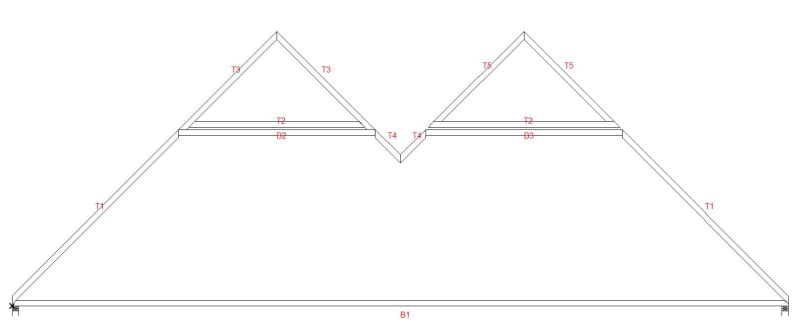RontheRedneck
Specifier/Regulator
- Jan 1, 2014
- 277
This subject came up the other day, and I said I'd try to do a thread on it.
I figure most of you know a lot about them. So there are only a couple of practical things I can talk about that might be helpful.
I created this fictitious truss to show one of the things I'd like to suggest to any of you who deal with piggybacked trusses. Note that the 2 caps are different.

The cap on the left has extended top chords that go to the flat TC on the base truss. This is the most common type of cap that I see.
Of course the design of the base truss requires that the flat TC of the base truss have 2X4 purlins on it, and the cap sits on top of them. That's documented in the packet of information that we send out with the trusses. (The same packet that usually gets thrown in the trash as the truck pulls off the jobsite)
I do caps like the one on the right. The TC of the cap does not extend down to the flat TC on the base truss. So if the framer has no clue what they're doing, they'll call us and tell us the cap trusses don't fit. Then we can explain to them what needs done. And there's a much greater chance that the purlins will actually get installed.
If a base truss is really large, the flat TC can be sheathed with plywood. Alpine typically recommends or requires that in some cases. Such as:
The flat TC of the base truss is more than half the span.
The flat TC has more than 5,000# of compression
If it's a double cap. (i.e. the cap truss is capped)
I think this is a good idea on really long span or exceptionally tall trusses, for a couple of reasons.
One is that it does a much better job of bracing the flat top chord of the brace truss. It also gives the workers a flat platform to work off of to set the base trusses.
If any of you work with large PB trusses I'd suggest considering it.
I figure most of you know a lot about them. So there are only a couple of practical things I can talk about that might be helpful.
I created this fictitious truss to show one of the things I'd like to suggest to any of you who deal with piggybacked trusses. Note that the 2 caps are different.

The cap on the left has extended top chords that go to the flat TC on the base truss. This is the most common type of cap that I see.
Of course the design of the base truss requires that the flat TC of the base truss have 2X4 purlins on it, and the cap sits on top of them. That's documented in the packet of information that we send out with the trusses. (The same packet that usually gets thrown in the trash as the truck pulls off the jobsite)
I do caps like the one on the right. The TC of the cap does not extend down to the flat TC on the base truss. So if the framer has no clue what they're doing, they'll call us and tell us the cap trusses don't fit. Then we can explain to them what needs done. And there's a much greater chance that the purlins will actually get installed.
If a base truss is really large, the flat TC can be sheathed with plywood. Alpine typically recommends or requires that in some cases. Such as:
The flat TC of the base truss is more than half the span.
The flat TC has more than 5,000# of compression
If it's a double cap. (i.e. the cap truss is capped)
I think this is a good idea on really long span or exceptionally tall trusses, for a couple of reasons.
One is that it does a much better job of bracing the flat top chord of the brace truss. It also gives the workers a flat platform to work off of to set the base trusses.
If any of you work with large PB trusses I'd suggest considering it.


